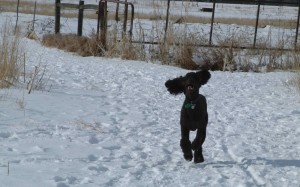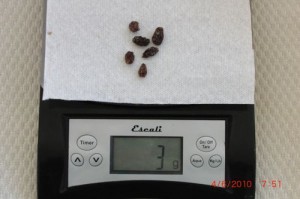Have you noticed? Raisins are everywhere. They’re in cookies, trail mix, red cardboard boxes, children’s sticky hands, and big plastic bags from the bulk department of your grocery.

Good for humans, not for dogs!
And they also can end up in your dog and that is very bad because raisins, and their plumped up previous incarnation as grapes, are toxic to our canine friends.Those sweet little fruits that are nutritious for us can be lethal to our dogs, sending them into kidney failure. Fast. And the kicker is, we don’t know why.
When I hit a patch of writer’s block, I Google. It’s my favorite procrastinative indulgence. “Poison dogs” or “dog toxins” have delivered me to websites listing the usual suspects–chocolate, macadamia nuts, coffee beans and grounds, onions, and, yes, grapes and raisins. I never ventured beyond simple lists into thickets of raisin toxicity. I just knew they were bad. So, when Ira accidently dropped a raisin from the handful of trail mix he was eating and Sadie scarfed it up before I had the presence of mind to yell “Wait!” I needed to calm myself against rising dread. It was just one tiny raisin vs. fifty pounds of poodle. No contest. Forget about it.
Thirty minutes later Sadie retched and threw up. It was 4:30 in the afternoon. Sadie has never vomited at 4:30 in the afternoon.
I panicked. I was certain the raisin had to have been the cause even though there was no raisin in the vomit.
I immediately called the veterinarian at our local pet emergency hospital who told me to call the ASPCA Animal Poison Control Center hot line, (888) 426-4435.
Let me pause here to say that the ASPCA Animal Poison Control Center is a fabulous resource. The doctors, all toxicologists, are very knowledgeable and patient, and they have access to a current database of poisons and their antidotes. For $65 the ASPCA doctor assessed Sadie’s situation, opened a case file, gave me a case number, and told me that the fee included as many consultations that I and my vet wanted regarding Sadie’s raisin episode. “Just refer to the case number when you call back.”
“The safest thing to do is get the raisin out if you can,” the ASPCA toxicologist continued. She told me to induce vomiting with hydrogen peroxide (3 tablespoons of peroxide and 1 tablespoon of milk) and to then call her back.
Sadie did not willingly swill her cocktail, so I poured it down her throat. I hated doing that with her “whale eye” staring up at me, but I was more afraid of the damage the raisin could do than I was repulsed at myself for forcing the liquid down her gullet.
I waited for Sadie to vomit, which she did in a matter of minutes. Bound and determined to find the errant raisin I followed Sadie around combing through the foamy mucous as she vomited again and again, probably six times in all. Ira brought up the rear with paper towels and soapy water.
I called the ASPCA hot line back. “Sadie did not throw up the raisin!”
The kind doctor explained that even when vomiting is induced sometimes only 75-80% of the stomach contents are emptied. So the raisin was either still in her stomach or it was on its way through her digestive tract.
“Now what?” My voice quivered.
“Well, we don’t yet know the minimum toxic dose for raisins or even why they are toxic. However, it was only one raisin, so you could “wait and see” if she vomits more, becomes anorexic, has diarrhea, becomes lethargic, urinates a lot or not at all, drinks a lot of water or none at all. Or, you could take Sadie to the ER and do a blood test to establish a baseline reading of her kidney function and have them administer IV fluids for 12-24 hours to flush her kidneys. They could also give her activated charcoal to absorb toxins, but that could elevate her sodium levels, so she would need to be watched carefully.”
“Wait and see” is not my strong suit. And besides, by the time Sadie showed clinical symptoms, if she was going to show them at all, I was afraid her kidneys already would be compromised.
I felt torn. Part of me thought Sadie would be fine—it was, after all, only one raisin. Part of me did not want to gamble. Part of me thought I was overreacting. Part of me didn’t want to put Sadie through the trauma of going to the ER. Part of me clutched at the thought of how much the ER would cost. Part of me pushed me out of the door and Sadie into the car. Ira drove us to the ER.
I explained to the ER doctor what the ASPCA toxicologist had said. I told her I felt foolish going to the max for one raisin but that I would be devastated if Sadie’s kidneys failed. She listened to me, said she agreed with the toxicologist, and refused to reassure me that one raisin was no big deal. Maybe it was. Maybe it wasn’t. There was no way to know for sure. Finally, I decided. “Let’s do blood tests, fluids, and charcoal.” The ER doctor agreed, but first she took Sadie’s case number and called the ASPCA to confer with their veterinarian. I was grateful for that. I liked that everybody would be on the same page.
Thirty-six hours later, after conferring with my regular veterinarian and receiving reports that Sadie was doing very well and that her second blood test after 24 hours of fluids was normal, I decided to stop the treatment.
My girl was all over me with kisses and wiggles when I picked her up and her energy level was fantastic. I think all the fluids, whether or not the raisin had adversely affected her, left Sadie feeling very chipper. In our dry, mountain desert climate I think many of us, humans and animals alike, are borderline dehydrated most of the time!
The veterinarian who discharged Sadie suggested that we do another blood test in 24 hours to be certain her kidneys were functioning properly since she would no longer be receiving the benefit of extra fluids. “There is no guarantee,” he cautioned, “that the raisin toxins have totally cleared her body.” He explained that to flush her kidneys and to prevent possible renal failure she was given twice her (ideal) normal intake of fluids. Now her kidneys were working on their own. “Okay. We’ll be back in 24 hours, tomorrow morning.”
After leaving the ER, Sadie and I enjoyed one our favorite long walks through a patchwork of pastures with views of the Great Divide. For the next four days she was on top of the world—playing, eating, drinking, pooping and peeing, running around, and taunting her best friends Romeo and Moses. She
a patchwork of pastures with views of the Great Divide. For the next four days she was on top of the world—playing, eating, drinking, pooping and peeing, running around, and taunting her best friends Romeo and Moses. She  was doing so well, I didn’t go back for that final blood test.
was doing so well, I didn’t go back for that final blood test.
I had picked Sadie up from the ER on a Friday morning, the following Tuesday morning she vomited and refused breakfast. I tried to coax her to eat by offering liver bits, peanut butter, freeze dried beef hearts, feta cheese—all her favorite treats. Nothing.
If you think I panicked when Sadie ate the raisin, I was now in freak-out overdrive. Why didn’t I do that follow-up blood test at 24 hours? Could we have detected her kidneys failing before these clinical signs of vomiting and anorexia showed up! Please don’t let it be too late. Please.
I hurriedly cancelled our morning training session with Gigi and rushed Sadie to our vet’s office. The tech drew blood and then I waited. And waited. Finally, an eternity of two hours later, our veterinarian called. “Sadie’s kidneys are fine. Everything is normal. I can see, though, why you were upset because of what you just went through with the raisin. But, I think she just had a little tummy upset. If she continues not to eat or vomits again, bring her in.”
Sadie was back to her usual ravenous self by dinner and she’s been fine ever since. I guess it was just an unfortunate coincidence that she had one of her very occasional morning tummy upsets on the heels of the raisin caper.
Later that evening I followed up with the ASPCA. They want to know outcomes so they can keep their database of toxins and treatments current.
I had an informative chat with the ASPCA toxicologist about raisins and grapes. Here’s what I learned:
- Dogs and raisins/grapes have been around a long time but it’s only been in the last 15 years or so that we’ve recognized that the fruit is a kidney toxin to dogs.
- Organic raisins/grapes apparently are no less toxic than non-organic ones.
- We don’t know what it is in raisins/grapes that make them toxic to dogs.
- A toxic reaction, kidney failure, might not be dose dependent. “We can’t say with certainty that fewer raisins/grapes are less toxic than lots of them. It appears to be idiosyncratic. Maybe some dogs are genetically predisposed to being unable to tolerate even one raisin/grape. We just don’t know.”
- That said, the lowest toxic dose reported so far is about 3 grams (.11 oz.) of raisins per 1 kilogram (2.2

This is what 3 grams of raisins looks like
pounds) of dog weight, or about 20 grams (.7 oz.) of grapes per 1 kilogram of dog weight. You can read research abstracts here, here, and here.
The bottom line is this: Please protect your dog from getting into raisins and grapes!
If your dog does eat raisins or grapes, call the ASPCA Poison Control Center–(888) 426-4435–even if your dog doesn’t get sick. Not all do. Regardless, since there are no experimental data on dogs and raisin toxicity, your anecdotal story about how many raisins, more or less, your dog ate and how he or she reacted, if at all, and what you did, if anything, is valuable information that can be of help to all dog owners and dogs.










That is so scary. I’m glad she is OK.
You are one amazing fur mom! I’m so glad that it all turned out for the good and that Sadie is okay.
I knew a woman who had a Pom that she would feed grapes to as a treat. I continually informed her that grapes are poisonous but she never listened and insisted it was fine. I will never understand why some people don’t listen to all the evidence.
That’s what’s so weird about raisins and grapes—some dogs’ kidney’s fail and others don’t. Even my vet said when she was a kid she fed her dog raisins as treats with no adverse effect.
But, I’m with you. I don’t like taking chances with Sadie’s health.
I’m so glad your dog is okay. My whole family is on pins and needles waiting to find out if our little dog will be okay. He got into my daughter’s trail mix today. I knew that raisins were toxic, so we got him to the vet within the hour or so. He’ll be there for 2 full days. My kids are extremely upset, as am I. It was an unfortunate accident and I blame myself. Our little dog has been through so much already . We just adopted him about three months ago, and I know he hasn’t had the best life so far. I just pray that he is one of the lucky ones. I have no idea how much he ate, but when they got him to vomit, they counted about 6. He’s only 15 lbs. They did the charcoal, and he’s now on IV fluids. I’m so worried that he’ll die and my little girl will never forgive herself for leaving them out. They are all sick with worry.
Dear Laurie
Dear Laurie
I´m so sorry. I know how gut-wrenching it is when our dogs are ill. I know what you mean by ¨sick with worry.¨ I´ve been there with Sadie and with my previous dogs. It sounds like you are doing all the right things–you took your pup to the vet within an hour, IV fluids for 48 hours, and charcoal to remove toxins. Know you´re not alone in praying for your pup´s full recovery.
Reply